Analysis of Consumer Buyer Behaviour: IKEA Corporation Report
VerifiedAdded on 2020/02/14
|13
|3370
|58
Report
AI Summary
This report provides a comprehensive analysis of consumer buyer behavior, specifically focusing on the IKEA Corporation within the furniture industry. It begins by examining the shopping and purchasing environment, highlighting factors such as product displays, categorization, store decoration, and the availability of friendly staff. The report then delves into consumer perception, exploring the impact of price, quality, promotions, ethical considerations, and store location. Further, the report analyzes consumer motivation and values, including the application of Maslow's hierarchy of needs and the importance of consumer involvement. It also discusses the role of marketing communications in shaping consumer attitudes, utilizing the ABC model and the hierarchy of effects. Finally, the report outlines IKEA's decision-making process, including need recognition, information search, evaluation of alternatives, strategy selection, and post-evaluation, offering recommendations for enhancing consumer strategies within the market.

BUYER BEHAVIOUR-
REPORT
REPORT
Paraphrase This Document
Need a fresh take? Get an instant paraphrase of this document with our AI Paraphraser

TABLE OF CONTENTS
INTRODUCTION...........................................................................................................................1
Shopping and purchasing environment..................................................................................1
Perception of consumer regarding product.............................................................................2
Motivation and values............................................................................................................3
Attitudes.................................................................................................................................4
Decision making.....................................................................................................................6
Recommendations..................................................................................................................7
CONCLUSION................................................................................................................................8
REFERENCES................................................................................................................................9
INTRODUCTION...........................................................................................................................1
Shopping and purchasing environment..................................................................................1
Perception of consumer regarding product.............................................................................2
Motivation and values............................................................................................................3
Attitudes.................................................................................................................................4
Decision making.....................................................................................................................6
Recommendations..................................................................................................................7
CONCLUSION................................................................................................................................8
REFERENCES................................................................................................................................9

ILLUSTRATION INDEX
Illustration 1: Effect of three hierarchy............................................................................................6
Illustration 1: Effect of three hierarchy............................................................................................6
⊘ This is a preview!⊘
Do you want full access?
Subscribe today to unlock all pages.

Trusted by 1+ million students worldwide
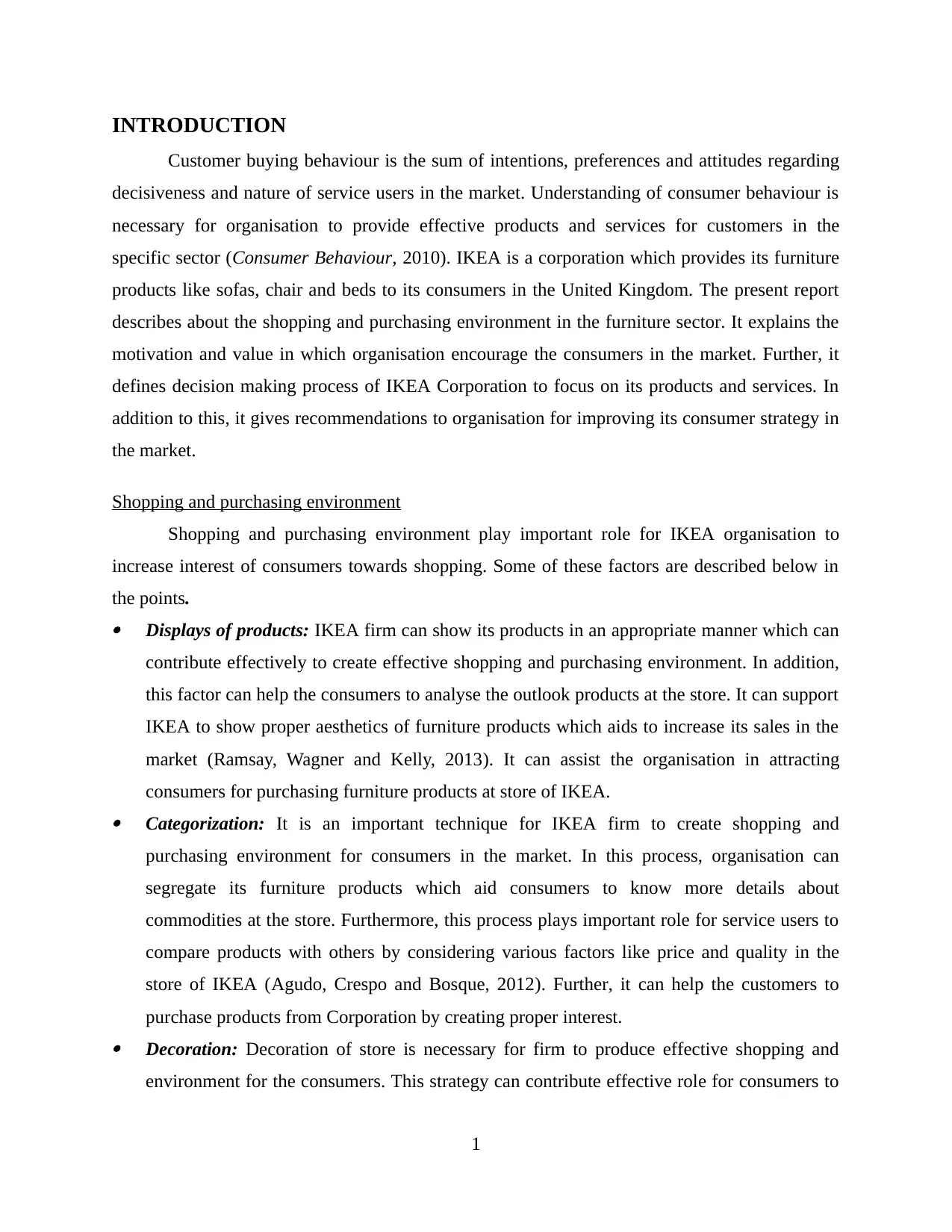
INTRODUCTION
Customer buying behaviour is the sum of intentions, preferences and attitudes regarding
decisiveness and nature of service users in the market. Understanding of consumer behaviour is
necessary for organisation to provide effective products and services for customers in the
specific sector (Consumer Behaviour, 2010). IKEA is a corporation which provides its furniture
products like sofas, chair and beds to its consumers in the United Kingdom. The present report
describes about the shopping and purchasing environment in the furniture sector. It explains the
motivation and value in which organisation encourage the consumers in the market. Further, it
defines decision making process of IKEA Corporation to focus on its products and services. In
addition to this, it gives recommendations to organisation for improving its consumer strategy in
the market.
Shopping and purchasing environment
Shopping and purchasing environment play important role for IKEA organisation to
increase interest of consumers towards shopping. Some of these factors are described below in
the points. Displays of products: IKEA firm can show its products in an appropriate manner which can
contribute effectively to create effective shopping and purchasing environment. In addition,
this factor can help the consumers to analyse the outlook products at the store. It can support
IKEA to show proper aesthetics of furniture products which aids to increase its sales in the
market (Ramsay, Wagner and Kelly, 2013). It can assist the organisation in attracting
consumers for purchasing furniture products at store of IKEA. Categorization: It is an important technique for IKEA firm to create shopping and
purchasing environment for consumers in the market. In this process, organisation can
segregate its furniture products which aid consumers to know more details about
commodities at the store. Furthermore, this process plays important role for service users to
compare products with others by considering various factors like price and quality in the
store of IKEA (Agudo, Crespo and Bosque, 2012). Further, it can help the customers to
purchase products from Corporation by creating proper interest. Decoration: Decoration of store is necessary for firm to produce effective shopping and
environment for the consumers. This strategy can contribute effective role for consumers to
1
Customer buying behaviour is the sum of intentions, preferences and attitudes regarding
decisiveness and nature of service users in the market. Understanding of consumer behaviour is
necessary for organisation to provide effective products and services for customers in the
specific sector (Consumer Behaviour, 2010). IKEA is a corporation which provides its furniture
products like sofas, chair and beds to its consumers in the United Kingdom. The present report
describes about the shopping and purchasing environment in the furniture sector. It explains the
motivation and value in which organisation encourage the consumers in the market. Further, it
defines decision making process of IKEA Corporation to focus on its products and services. In
addition to this, it gives recommendations to organisation for improving its consumer strategy in
the market.
Shopping and purchasing environment
Shopping and purchasing environment play important role for IKEA organisation to
increase interest of consumers towards shopping. Some of these factors are described below in
the points. Displays of products: IKEA firm can show its products in an appropriate manner which can
contribute effectively to create effective shopping and purchasing environment. In addition,
this factor can help the consumers to analyse the outlook products at the store. It can support
IKEA to show proper aesthetics of furniture products which aids to increase its sales in the
market (Ramsay, Wagner and Kelly, 2013). It can assist the organisation in attracting
consumers for purchasing furniture products at store of IKEA. Categorization: It is an important technique for IKEA firm to create shopping and
purchasing environment for consumers in the market. In this process, organisation can
segregate its furniture products which aid consumers to know more details about
commodities at the store. Furthermore, this process plays important role for service users to
compare products with others by considering various factors like price and quality in the
store of IKEA (Agudo, Crespo and Bosque, 2012). Further, it can help the customers to
purchase products from Corporation by creating proper interest. Decoration: Decoration of store is necessary for firm to produce effective shopping and
environment for the consumers. This strategy can contribute effective role for consumers to
1
Paraphrase This Document
Need a fresh take? Get an instant paraphrase of this document with our AI Paraphraser
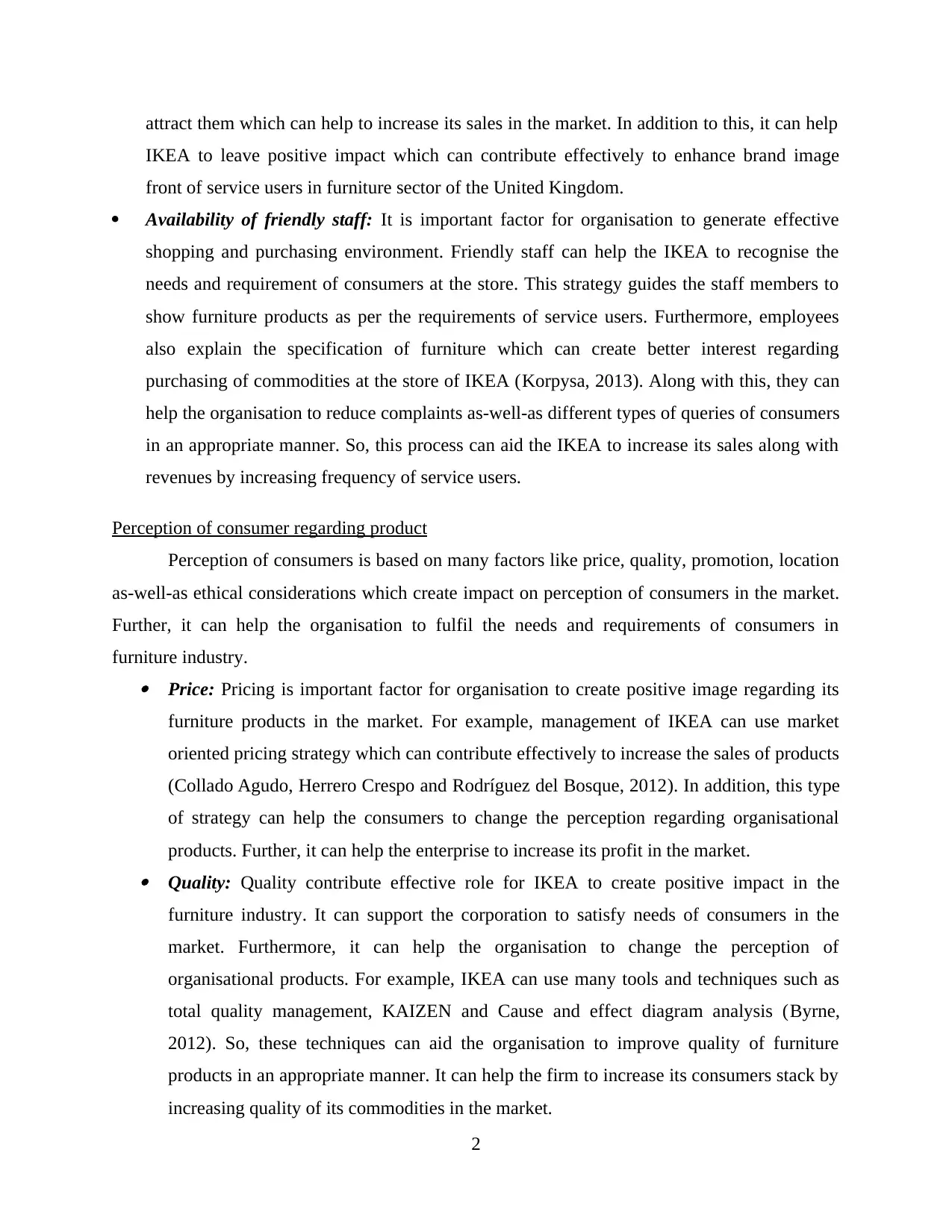
attract them which can help to increase its sales in the market. In addition to this, it can help
IKEA to leave positive impact which can contribute effectively to enhance brand image
front of service users in furniture sector of the United Kingdom.
Availability of friendly staff: It is important factor for organisation to generate effective
shopping and purchasing environment. Friendly staff can help the IKEA to recognise the
needs and requirement of consumers at the store. This strategy guides the staff members to
show furniture products as per the requirements of service users. Furthermore, employees
also explain the specification of furniture which can create better interest regarding
purchasing of commodities at the store of IKEA (Korpysa, 2013). Along with this, they can
help the organisation to reduce complaints as-well-as different types of queries of consumers
in an appropriate manner. So, this process can aid the IKEA to increase its sales along with
revenues by increasing frequency of service users.
Perception of consumer regarding product
Perception of consumers is based on many factors like price, quality, promotion, location
as-well-as ethical considerations which create impact on perception of consumers in the market.
Further, it can help the organisation to fulfil the needs and requirements of consumers in
furniture industry. Price: Pricing is important factor for organisation to create positive image regarding its
furniture products in the market. For example, management of IKEA can use market
oriented pricing strategy which can contribute effectively to increase the sales of products
(Collado Agudo, Herrero Crespo and Rodríguez del Bosque, 2012). In addition, this type
of strategy can help the consumers to change the perception regarding organisational
products. Further, it can help the enterprise to increase its profit in the market. Quality: Quality contribute effective role for IKEA to create positive impact in the
furniture industry. It can support the corporation to satisfy needs of consumers in the
market. Furthermore, it can help the organisation to change the perception of
organisational products. For example, IKEA can use many tools and techniques such as
total quality management, KAIZEN and Cause and effect diagram analysis (Byrne,
2012). So, these techniques can aid the organisation to improve quality of furniture
products in an appropriate manner. It can help the firm to increase its consumers stack by
increasing quality of its commodities in the market.
2
IKEA to leave positive impact which can contribute effectively to enhance brand image
front of service users in furniture sector of the United Kingdom.
Availability of friendly staff: It is important factor for organisation to generate effective
shopping and purchasing environment. Friendly staff can help the IKEA to recognise the
needs and requirement of consumers at the store. This strategy guides the staff members to
show furniture products as per the requirements of service users. Furthermore, employees
also explain the specification of furniture which can create better interest regarding
purchasing of commodities at the store of IKEA (Korpysa, 2013). Along with this, they can
help the organisation to reduce complaints as-well-as different types of queries of consumers
in an appropriate manner. So, this process can aid the IKEA to increase its sales along with
revenues by increasing frequency of service users.
Perception of consumer regarding product
Perception of consumers is based on many factors like price, quality, promotion, location
as-well-as ethical considerations which create impact on perception of consumers in the market.
Further, it can help the organisation to fulfil the needs and requirements of consumers in
furniture industry. Price: Pricing is important factor for organisation to create positive image regarding its
furniture products in the market. For example, management of IKEA can use market
oriented pricing strategy which can contribute effectively to increase the sales of products
(Collado Agudo, Herrero Crespo and Rodríguez del Bosque, 2012). In addition, this type
of strategy can help the consumers to change the perception regarding organisational
products. Further, it can help the enterprise to increase its profit in the market. Quality: Quality contribute effective role for IKEA to create positive impact in the
furniture industry. It can support the corporation to satisfy needs of consumers in the
market. Furthermore, it can help the organisation to change the perception of
organisational products. For example, IKEA can use many tools and techniques such as
total quality management, KAIZEN and Cause and effect diagram analysis (Byrne,
2012). So, these techniques can aid the organisation to improve quality of furniture
products in an appropriate manner. It can help the firm to increase its consumers stack by
increasing quality of its commodities in the market.
2
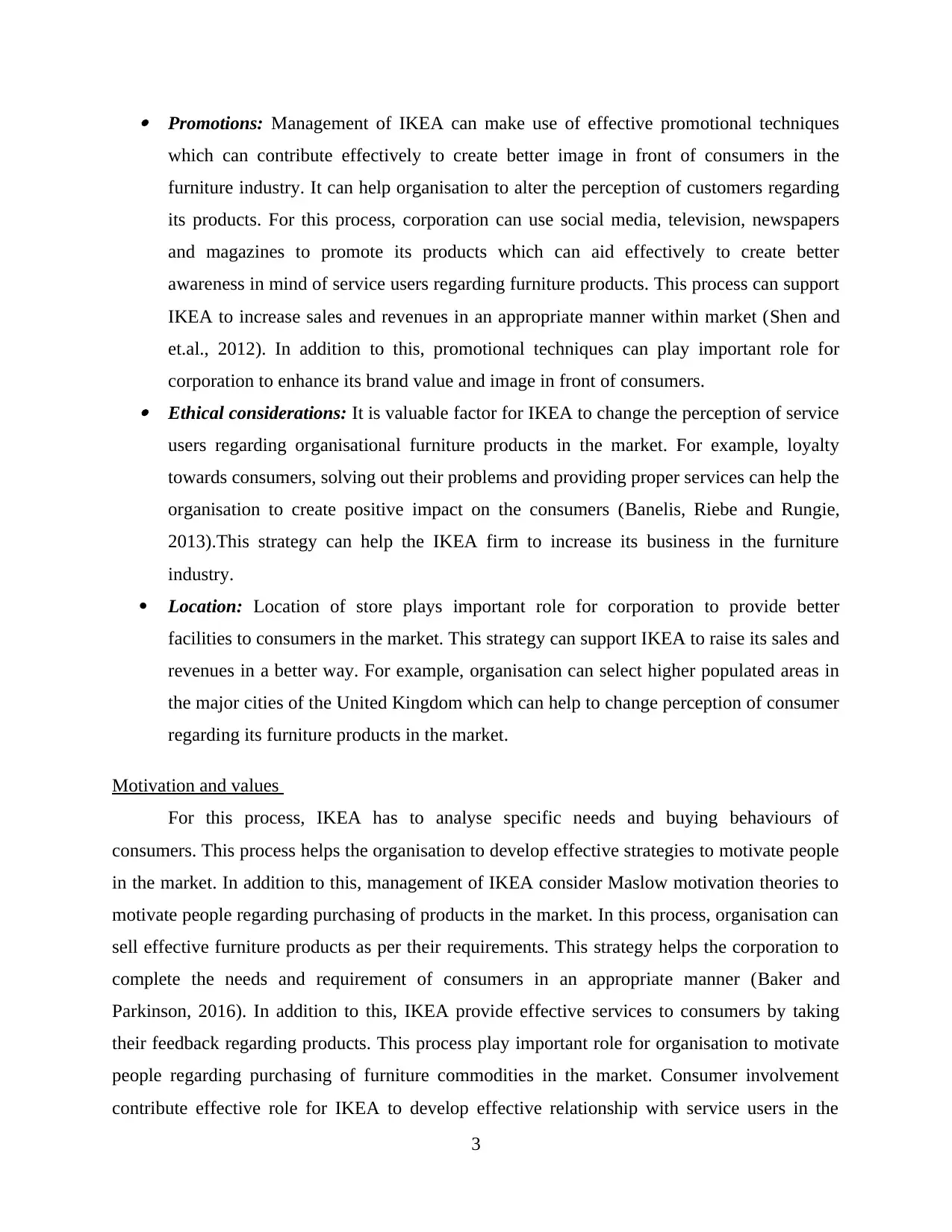
Promotions: Management of IKEA can make use of effective promotional techniques
which can contribute effectively to create better image in front of consumers in the
furniture industry. It can help organisation to alter the perception of customers regarding
its products. For this process, corporation can use social media, television, newspapers
and magazines to promote its products which can aid effectively to create better
awareness in mind of service users regarding furniture products. This process can support
IKEA to increase sales and revenues in an appropriate manner within market (Shen and
et.al., 2012). In addition to this, promotional techniques can play important role for
corporation to enhance its brand value and image in front of consumers. Ethical considerations: It is valuable factor for IKEA to change the perception of service
users regarding organisational furniture products in the market. For example, loyalty
towards consumers, solving out their problems and providing proper services can help the
organisation to create positive impact on the consumers (Banelis, Riebe and Rungie,
2013).This strategy can help the IKEA firm to increase its business in the furniture
industry.
Location: Location of store plays important role for corporation to provide better
facilities to consumers in the market. This strategy can support IKEA to raise its sales and
revenues in a better way. For example, organisation can select higher populated areas in
the major cities of the United Kingdom which can help to change perception of consumer
regarding its furniture products in the market.
Motivation and values
For this process, IKEA has to analyse specific needs and buying behaviours of
consumers. This process helps the organisation to develop effective strategies to motivate people
in the market. In addition to this, management of IKEA consider Maslow motivation theories to
motivate people regarding purchasing of products in the market. In this process, organisation can
sell effective furniture products as per their requirements. This strategy helps the corporation to
complete the needs and requirement of consumers in an appropriate manner (Baker and
Parkinson, 2016). In addition to this, IKEA provide effective services to consumers by taking
their feedback regarding products. This process play important role for organisation to motivate
people regarding purchasing of furniture commodities in the market. Consumer involvement
contribute effective role for IKEA to develop effective relationship with service users in the
3
which can contribute effectively to create better image in front of consumers in the
furniture industry. It can help organisation to alter the perception of customers regarding
its products. For this process, corporation can use social media, television, newspapers
and magazines to promote its products which can aid effectively to create better
awareness in mind of service users regarding furniture products. This process can support
IKEA to increase sales and revenues in an appropriate manner within market (Shen and
et.al., 2012). In addition to this, promotional techniques can play important role for
corporation to enhance its brand value and image in front of consumers. Ethical considerations: It is valuable factor for IKEA to change the perception of service
users regarding organisational furniture products in the market. For example, loyalty
towards consumers, solving out their problems and providing proper services can help the
organisation to create positive impact on the consumers (Banelis, Riebe and Rungie,
2013).This strategy can help the IKEA firm to increase its business in the furniture
industry.
Location: Location of store plays important role for corporation to provide better
facilities to consumers in the market. This strategy can support IKEA to raise its sales and
revenues in a better way. For example, organisation can select higher populated areas in
the major cities of the United Kingdom which can help to change perception of consumer
regarding its furniture products in the market.
Motivation and values
For this process, IKEA has to analyse specific needs and buying behaviours of
consumers. This process helps the organisation to develop effective strategies to motivate people
in the market. In addition to this, management of IKEA consider Maslow motivation theories to
motivate people regarding purchasing of products in the market. In this process, organisation can
sell effective furniture products as per their requirements. This strategy helps the corporation to
complete the needs and requirement of consumers in an appropriate manner (Baker and
Parkinson, 2016). In addition to this, IKEA provide effective services to consumers by taking
their feedback regarding products. This process play important role for organisation to motivate
people regarding purchasing of furniture commodities in the market. Consumer involvement
contribute effective role for IKEA to develop effective relationship with service users in the
3
⊘ This is a preview!⊘
Do you want full access?
Subscribe today to unlock all pages.

Trusted by 1+ million students worldwide
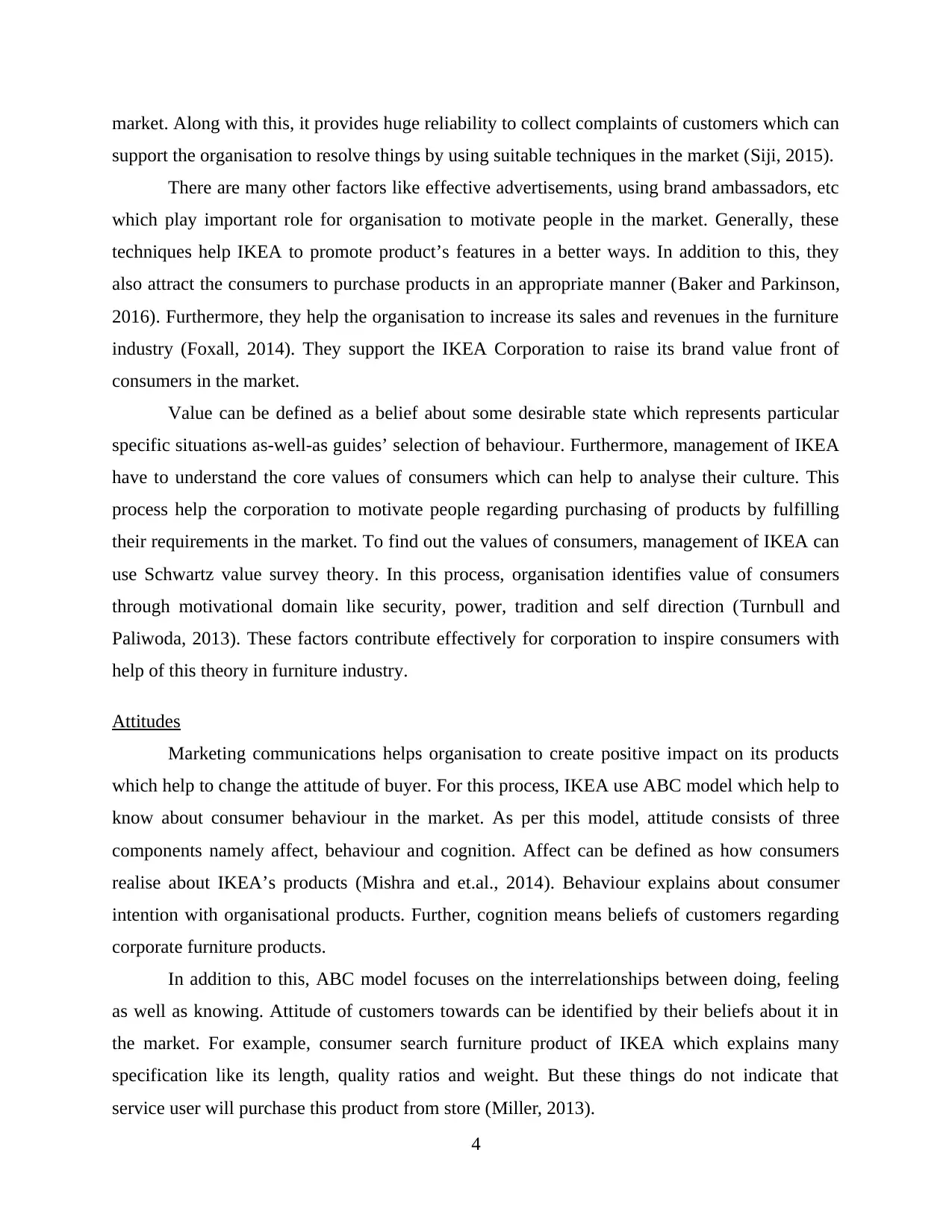
market. Along with this, it provides huge reliability to collect complaints of customers which can
support the organisation to resolve things by using suitable techniques in the market (Siji, 2015).
There are many other factors like effective advertisements, using brand ambassadors, etc
which play important role for organisation to motivate people in the market. Generally, these
techniques help IKEA to promote product’s features in a better ways. In addition to this, they
also attract the consumers to purchase products in an appropriate manner (Baker and Parkinson,
2016). Furthermore, they help the organisation to increase its sales and revenues in the furniture
industry (Foxall, 2014). They support the IKEA Corporation to raise its brand value front of
consumers in the market.
Value can be defined as a belief about some desirable state which represents particular
specific situations as-well-as guides’ selection of behaviour. Furthermore, management of IKEA
have to understand the core values of consumers which can help to analyse their culture. This
process help the corporation to motivate people regarding purchasing of products by fulfilling
their requirements in the market. To find out the values of consumers, management of IKEA can
use Schwartz value survey theory. In this process, organisation identifies value of consumers
through motivational domain like security, power, tradition and self direction (Turnbull and
Paliwoda, 2013). These factors contribute effectively for corporation to inspire consumers with
help of this theory in furniture industry.
Attitudes
Marketing communications helps organisation to create positive impact on its products
which help to change the attitude of buyer. For this process, IKEA use ABC model which help to
know about consumer behaviour in the market. As per this model, attitude consists of three
components namely affect, behaviour and cognition. Affect can be defined as how consumers
realise about IKEA’s products (Mishra and et.al., 2014). Behaviour explains about consumer
intention with organisational products. Further, cognition means beliefs of customers regarding
corporate furniture products.
In addition to this, ABC model focuses on the interrelationships between doing, feeling
as well as knowing. Attitude of customers towards can be identified by their beliefs about it in
the market. For example, consumer search furniture product of IKEA which explains many
specification like its length, quality ratios and weight. But these things do not indicate that
service user will purchase this product from store (Miller, 2013).
4
support the organisation to resolve things by using suitable techniques in the market (Siji, 2015).
There are many other factors like effective advertisements, using brand ambassadors, etc
which play important role for organisation to motivate people in the market. Generally, these
techniques help IKEA to promote product’s features in a better ways. In addition to this, they
also attract the consumers to purchase products in an appropriate manner (Baker and Parkinson,
2016). Furthermore, they help the organisation to increase its sales and revenues in the furniture
industry (Foxall, 2014). They support the IKEA Corporation to raise its brand value front of
consumers in the market.
Value can be defined as a belief about some desirable state which represents particular
specific situations as-well-as guides’ selection of behaviour. Furthermore, management of IKEA
have to understand the core values of consumers which can help to analyse their culture. This
process help the corporation to motivate people regarding purchasing of products by fulfilling
their requirements in the market. To find out the values of consumers, management of IKEA can
use Schwartz value survey theory. In this process, organisation identifies value of consumers
through motivational domain like security, power, tradition and self direction (Turnbull and
Paliwoda, 2013). These factors contribute effectively for corporation to inspire consumers with
help of this theory in furniture industry.
Attitudes
Marketing communications helps organisation to create positive impact on its products
which help to change the attitude of buyer. For this process, IKEA use ABC model which help to
know about consumer behaviour in the market. As per this model, attitude consists of three
components namely affect, behaviour and cognition. Affect can be defined as how consumers
realise about IKEA’s products (Mishra and et.al., 2014). Behaviour explains about consumer
intention with organisational products. Further, cognition means beliefs of customers regarding
corporate furniture products.
In addition to this, ABC model focuses on the interrelationships between doing, feeling
as well as knowing. Attitude of customers towards can be identified by their beliefs about it in
the market. For example, consumer search furniture product of IKEA which explains many
specification like its length, quality ratios and weight. But these things do not indicate that
service user will purchase this product from store (Miller, 2013).
4
Paraphrase This Document
Need a fresh take? Get an instant paraphrase of this document with our AI Paraphraser
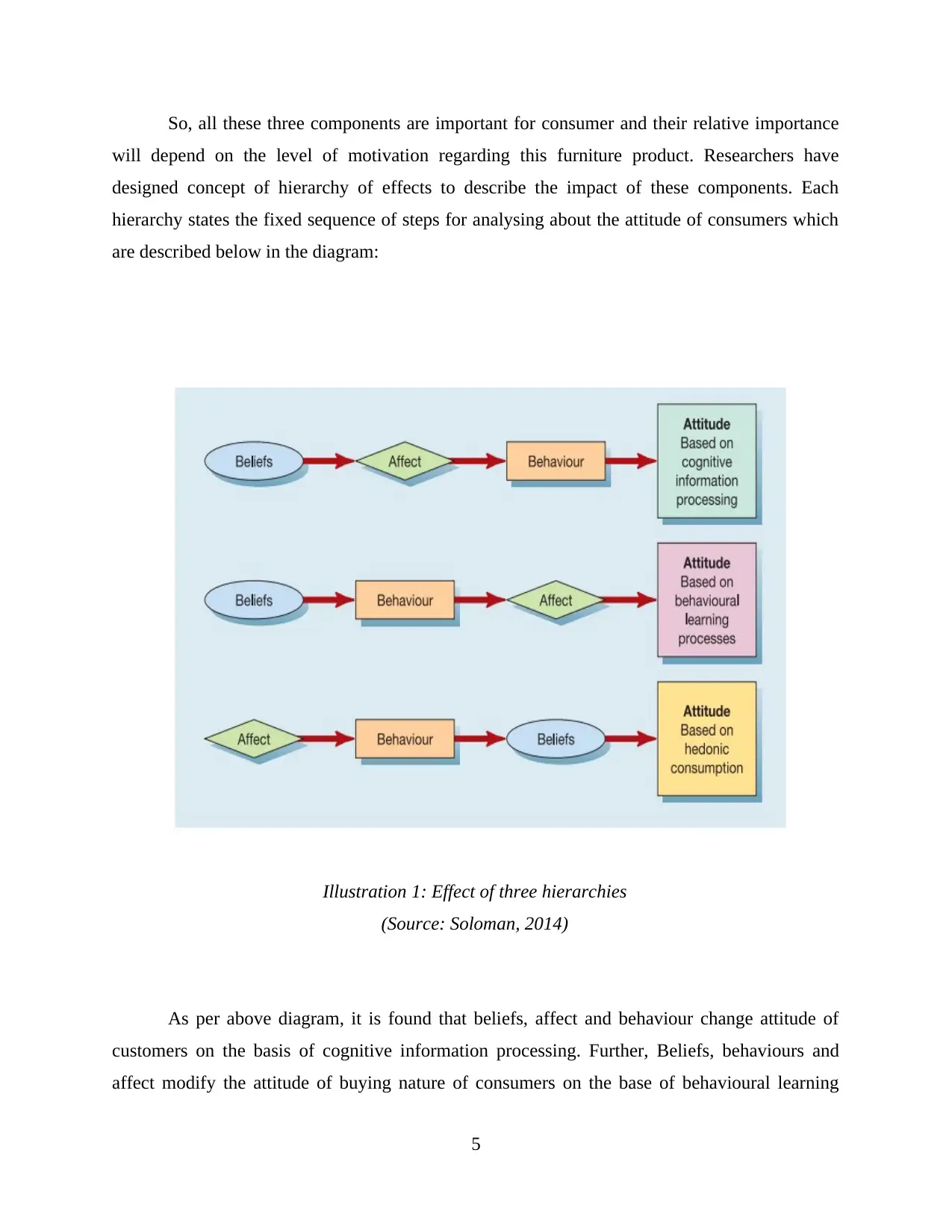
So, all these three components are important for consumer and their relative importance
will depend on the level of motivation regarding this furniture product. Researchers have
designed concept of hierarchy of effects to describe the impact of these components. Each
hierarchy states the fixed sequence of steps for analysing about the attitude of consumers which
are described below in the diagram:
As per above diagram, it is found that beliefs, affect and behaviour change attitude of
customers on the basis of cognitive information processing. Further, Beliefs, behaviours and
affect modify the attitude of buying nature of consumers on the base of behavioural learning
5
Illustration 1: Effect of three hierarchies
(Source: Soloman, 2014)
will depend on the level of motivation regarding this furniture product. Researchers have
designed concept of hierarchy of effects to describe the impact of these components. Each
hierarchy states the fixed sequence of steps for analysing about the attitude of consumers which
are described below in the diagram:
As per above diagram, it is found that beliefs, affect and behaviour change attitude of
customers on the basis of cognitive information processing. Further, Beliefs, behaviours and
affect modify the attitude of buying nature of consumers on the base of behavioural learning
5
Illustration 1: Effect of three hierarchies
(Source: Soloman, 2014)
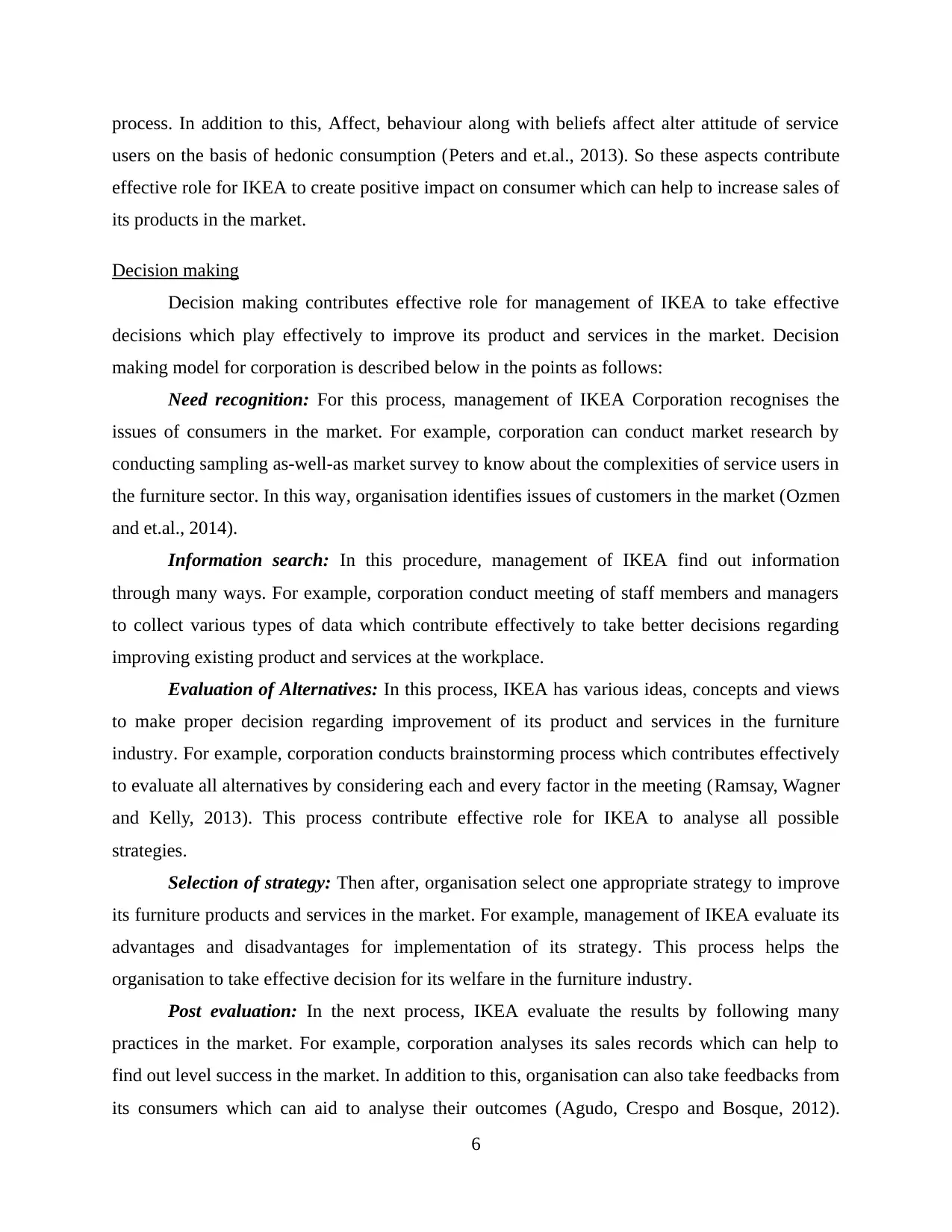
process. In addition to this, Affect, behaviour along with beliefs affect alter attitude of service
users on the basis of hedonic consumption (Peters and et.al., 2013). So these aspects contribute
effective role for IKEA to create positive impact on consumer which can help to increase sales of
its products in the market.
Decision making
Decision making contributes effective role for management of IKEA to take effective
decisions which play effectively to improve its product and services in the market. Decision
making model for corporation is described below in the points as follows:
Need recognition: For this process, management of IKEA Corporation recognises the
issues of consumers in the market. For example, corporation can conduct market research by
conducting sampling as-well-as market survey to know about the complexities of service users in
the furniture sector. In this way, organisation identifies issues of customers in the market (Ozmen
and et.al., 2014).
Information search: In this procedure, management of IKEA find out information
through many ways. For example, corporation conduct meeting of staff members and managers
to collect various types of data which contribute effectively to take better decisions regarding
improving existing product and services at the workplace.
Evaluation of Alternatives: In this process, IKEA has various ideas, concepts and views
to make proper decision regarding improvement of its product and services in the furniture
industry. For example, corporation conducts brainstorming process which contributes effectively
to evaluate all alternatives by considering each and every factor in the meeting (Ramsay, Wagner
and Kelly, 2013). This process contribute effective role for IKEA to analyse all possible
strategies.
Selection of strategy: Then after, organisation select one appropriate strategy to improve
its furniture products and services in the market. For example, management of IKEA evaluate its
advantages and disadvantages for implementation of its strategy. This process helps the
organisation to take effective decision for its welfare in the furniture industry.
Post evaluation: In the next process, IKEA evaluate the results by following many
practices in the market. For example, corporation analyses its sales records which can help to
find out level success in the market. In addition to this, organisation can also take feedbacks from
its consumers which can aid to analyse their outcomes (Agudo, Crespo and Bosque, 2012).
6
users on the basis of hedonic consumption (Peters and et.al., 2013). So these aspects contribute
effective role for IKEA to create positive impact on consumer which can help to increase sales of
its products in the market.
Decision making
Decision making contributes effective role for management of IKEA to take effective
decisions which play effectively to improve its product and services in the market. Decision
making model for corporation is described below in the points as follows:
Need recognition: For this process, management of IKEA Corporation recognises the
issues of consumers in the market. For example, corporation can conduct market research by
conducting sampling as-well-as market survey to know about the complexities of service users in
the furniture sector. In this way, organisation identifies issues of customers in the market (Ozmen
and et.al., 2014).
Information search: In this procedure, management of IKEA find out information
through many ways. For example, corporation conduct meeting of staff members and managers
to collect various types of data which contribute effectively to take better decisions regarding
improving existing product and services at the workplace.
Evaluation of Alternatives: In this process, IKEA has various ideas, concepts and views
to make proper decision regarding improvement of its product and services in the furniture
industry. For example, corporation conducts brainstorming process which contributes effectively
to evaluate all alternatives by considering each and every factor in the meeting (Ramsay, Wagner
and Kelly, 2013). This process contribute effective role for IKEA to analyse all possible
strategies.
Selection of strategy: Then after, organisation select one appropriate strategy to improve
its furniture products and services in the market. For example, management of IKEA evaluate its
advantages and disadvantages for implementation of its strategy. This process helps the
organisation to take effective decision for its welfare in the furniture industry.
Post evaluation: In the next process, IKEA evaluate the results by following many
practices in the market. For example, corporation analyses its sales records which can help to
find out level success in the market. In addition to this, organisation can also take feedbacks from
its consumers which can aid to analyse their outcomes (Agudo, Crespo and Bosque, 2012).
6
⊘ This is a preview!⊘
Do you want full access?
Subscribe today to unlock all pages.

Trusted by 1+ million students worldwide

Further, it can help IKEA organisation to improve its furniture products and services for
increasing its sales and revenues in furniture industry of the United Kingdom.
Recommendations
There are types of recommendations which help the corporation to improve its products
and services. These strategies help IKEA organisation to increase sales and revenues by
increasing its market share and growth in the furniture sector. They support the firm to improve
its consumer strategies in the market.
Management of IKEA should conduct online and offline marketing research in regular
time intervals in the market. This process can help the organisation to develop furniture products
as per requirements of consumers in the market. In addition to this, it can help the organisation to
increase its sales which can support to increase profit and change consumer strategies in the
market.
IKEA should use technological tools like ERP (Enterprises Resource Planning) and
Consumer Relationship Management (CRM). Generally, ERP tool can help the IKEA to assess
the fast information which can contribute effectively to take better decision on the basis of latest.
In addition to this, CRM tool help the corporation to take records of customer complaints and
feedback (Korpysa, 2013). It supports the organisation to resolve out consumer queries which
can support to change consumer strategies. Along with this, these tools can help the IKEA to
increase its efficiency and performance in furniture sector of United Kingdom.
Management of organisation should use effective promotional techniques to promote its
new and existing products in the market. This process aid IKEA to describe its product
characteristic in-front of consumers which to improve present consumer strategies. It helps the
organisation to increase its sales and revenues in the furniture industry of the United Kingdom.
IKEA improve its quality of products by implementing total quality management,
continuous improvement and implementation of ISO rules and regulations. This process helps
the organisation to increase quality of products in comparison to previous years. Due to these
reasons, service users purchase more furniture products from store of IKEA in the market
(Byrne, 2012). In addition to this, they help the organisation to increase brand image and values
in-front of consumers in furniture sector.
7
increasing its sales and revenues in furniture industry of the United Kingdom.
Recommendations
There are types of recommendations which help the corporation to improve its products
and services. These strategies help IKEA organisation to increase sales and revenues by
increasing its market share and growth in the furniture sector. They support the firm to improve
its consumer strategies in the market.
Management of IKEA should conduct online and offline marketing research in regular
time intervals in the market. This process can help the organisation to develop furniture products
as per requirements of consumers in the market. In addition to this, it can help the organisation to
increase its sales which can support to increase profit and change consumer strategies in the
market.
IKEA should use technological tools like ERP (Enterprises Resource Planning) and
Consumer Relationship Management (CRM). Generally, ERP tool can help the IKEA to assess
the fast information which can contribute effectively to take better decision on the basis of latest.
In addition to this, CRM tool help the corporation to take records of customer complaints and
feedback (Korpysa, 2013). It supports the organisation to resolve out consumer queries which
can support to change consumer strategies. Along with this, these tools can help the IKEA to
increase its efficiency and performance in furniture sector of United Kingdom.
Management of organisation should use effective promotional techniques to promote its
new and existing products in the market. This process aid IKEA to describe its product
characteristic in-front of consumers which to improve present consumer strategies. It helps the
organisation to increase its sales and revenues in the furniture industry of the United Kingdom.
IKEA improve its quality of products by implementing total quality management,
continuous improvement and implementation of ISO rules and regulations. This process helps
the organisation to increase quality of products in comparison to previous years. Due to these
reasons, service users purchase more furniture products from store of IKEA in the market
(Byrne, 2012). In addition to this, they help the organisation to increase brand image and values
in-front of consumers in furniture sector.
7
Paraphrase This Document
Need a fresh take? Get an instant paraphrase of this document with our AI Paraphraser
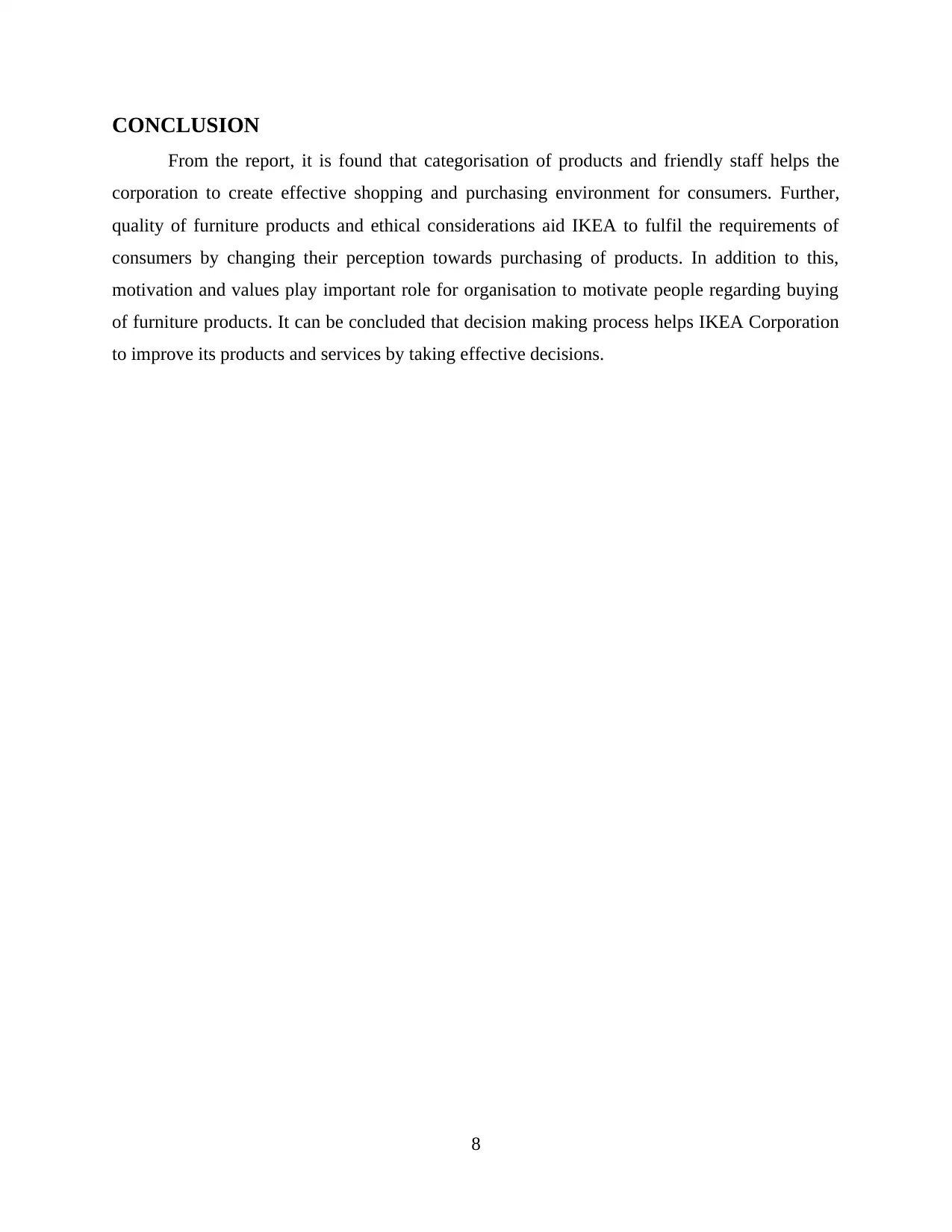
CONCLUSION
From the report, it is found that categorisation of products and friendly staff helps the
corporation to create effective shopping and purchasing environment for consumers. Further,
quality of furniture products and ethical considerations aid IKEA to fulfil the requirements of
consumers by changing their perception towards purchasing of products. In addition to this,
motivation and values play important role for organisation to motivate people regarding buying
of furniture products. It can be concluded that decision making process helps IKEA Corporation
to improve its products and services by taking effective decisions.
8
From the report, it is found that categorisation of products and friendly staff helps the
corporation to create effective shopping and purchasing environment for consumers. Further,
quality of furniture products and ethical considerations aid IKEA to fulfil the requirements of
consumers by changing their perception towards purchasing of products. In addition to this,
motivation and values play important role for organisation to motivate people regarding buying
of furniture products. It can be concluded that decision making process helps IKEA Corporation
to improve its products and services by taking effective decisions.
8

REFERENCES
Books and Journals
Agudo, J. C., Crespo, A. H. and Bosque, I. R., 2012. Adherence to customer loyalty programs
and changes in buyer behaviour. The Service Industries Journal. 32(8). pp.1323-134.
Baker, M. J. and Parkinson, S. T., 2016. Organizational buying behaviour: purchasing and
marketing management implications. Springer.
Banelis, M., Riebe, E. and Rungie, C. M., 2013. Empirical evidence of repertoire
size. Australasian Marketing Journal (AMJ). 21(1). pp.59-65.
Byrne, J. B., 2012. Evaluating the power of online forums in consumer buyer behaviour. NAISIT
Publisher.
Collado Agudo, J., Herrero Crespo, A. and Rodríguez del Bosque, I., 2012. Adherence to
customer loyalty programmes and changes in buyer behaviour. The Service Industries
Journal. 32(8). pp.1323-1341.
Foxall, G.R., 2014. Consumer Behaviour (RLE Consumer Behaviour): A Practical Guide (Vol.
3). Routledge.'
Korpysa, J., 2013. Buyer behaviour in the context of sustainable consumption policy pursued in
Poland. Amfiteatru Economic. 15. pp.702.
Miller, K., 2013. Hedonic customer responses to fast fashion and replicas. Journal of Fashion
Marketing and Management: An International Journal. 17(2). pp.160-174.
Mishra, J. K. and et.al., 2014. Money attitudes as predictors of materialism and compulsive
buying, and gender demographics, in the ‘new India’. International Journal of Indian
Culture and Business Management. 9(3). pp.301-315.
Ozmen, E. S. and et.al., SME buying behaviour: Literature review and an application
agenda. The Marketing Review. 13(2). pp.207-227.
Peters, L. D. and et.al., 2013. Theoretical developments in industrial marketing management:
Multidisciplinary perspectives. Industrial Marketing Management. 42(3). pp.275-282.
Ramsay, J., Wagner, B. and Kelly, S., 2013. Purchase offering quality: The effects of buyer
behaviour on organizational supplying behaviour. International Journal of Operations &
Production Management. 33(10). pp.1260-1282.
Shen, B. and et.al., 2012. The impact of ethical fashion on consumer purchase behavior. Journal
of Fashion Marketing and Management: An International Journal. 16(2). pp.234-245.
Siji, S., 2015. Variance in factors influencing buyer behaviour across various product categories
in FMCGs. Indian Journal of Marketing. 45(3). pp.54-68.
9
Books and Journals
Agudo, J. C., Crespo, A. H. and Bosque, I. R., 2012. Adherence to customer loyalty programs
and changes in buyer behaviour. The Service Industries Journal. 32(8). pp.1323-134.
Baker, M. J. and Parkinson, S. T., 2016. Organizational buying behaviour: purchasing and
marketing management implications. Springer.
Banelis, M., Riebe, E. and Rungie, C. M., 2013. Empirical evidence of repertoire
size. Australasian Marketing Journal (AMJ). 21(1). pp.59-65.
Byrne, J. B., 2012. Evaluating the power of online forums in consumer buyer behaviour. NAISIT
Publisher.
Collado Agudo, J., Herrero Crespo, A. and Rodríguez del Bosque, I., 2012. Adherence to
customer loyalty programmes and changes in buyer behaviour. The Service Industries
Journal. 32(8). pp.1323-1341.
Foxall, G.R., 2014. Consumer Behaviour (RLE Consumer Behaviour): A Practical Guide (Vol.
3). Routledge.'
Korpysa, J., 2013. Buyer behaviour in the context of sustainable consumption policy pursued in
Poland. Amfiteatru Economic. 15. pp.702.
Miller, K., 2013. Hedonic customer responses to fast fashion and replicas. Journal of Fashion
Marketing and Management: An International Journal. 17(2). pp.160-174.
Mishra, J. K. and et.al., 2014. Money attitudes as predictors of materialism and compulsive
buying, and gender demographics, in the ‘new India’. International Journal of Indian
Culture and Business Management. 9(3). pp.301-315.
Ozmen, E. S. and et.al., SME buying behaviour: Literature review and an application
agenda. The Marketing Review. 13(2). pp.207-227.
Peters, L. D. and et.al., 2013. Theoretical developments in industrial marketing management:
Multidisciplinary perspectives. Industrial Marketing Management. 42(3). pp.275-282.
Ramsay, J., Wagner, B. and Kelly, S., 2013. Purchase offering quality: The effects of buyer
behaviour on organizational supplying behaviour. International Journal of Operations &
Production Management. 33(10). pp.1260-1282.
Shen, B. and et.al., 2012. The impact of ethical fashion on consumer purchase behavior. Journal
of Fashion Marketing and Management: An International Journal. 16(2). pp.234-245.
Siji, S., 2015. Variance in factors influencing buyer behaviour across various product categories
in FMCGs. Indian Journal of Marketing. 45(3). pp.54-68.
9
⊘ This is a preview!⊘
Do you want full access?
Subscribe today to unlock all pages.

Trusted by 1+ million students worldwide
1 out of 13
Related Documents
Your All-in-One AI-Powered Toolkit for Academic Success.
+13062052269
info@desklib.com
Available 24*7 on WhatsApp / Email
![[object Object]](/_next/static/media/star-bottom.7253800d.svg)
Unlock your academic potential
Copyright © 2020–2025 A2Z Services. All Rights Reserved. Developed and managed by ZUCOL.





